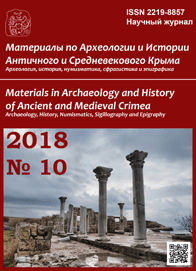Парфянские и раннесасанидские «импорты» в погребениях кочевников Восточной Европы (II в. до н.э.— III в. н.э.)
Parthian and Early Sasanian “Imports” in the Burials of the Nomads of Eastern Europe (2nd Century BCE — 3rd Century CE)
Author(s): Mikhail Ju. TreisterSubject(s): History
Published by: Нижневартовский государственный университет
Keywords: Parthia; Sarmatia; contacts; written sources; archaeological data; silver and gold vessels; phalerae; jewelry; glazed pottery; arms; belt sets
Summary/Abstract: The article is devoted to the analysis of archaeological materials testifying to the contacts of the nomads of Sarmatia and Parthia and their comparison with the data of written sources. The analysis has shown that the items, which more or less likely can be attributed as Parthian, fell to the nomads of Sarmatia throughout all the history of Parthia. The motifs of Parthian art found reflection in objects made outside Parthia, probably in a nomadic environment. For different periods characteristic is the inflow of certain categories of objects and their localization. Separate finds and find complexes may be associated with events known to us from written sources, the contacts of the nomads with Iran. In general, the archaeological evidence of contacts in question does not allow us to speak of the penetration of Parthian products as a result of regular trading contacts, but rather as evidence of gifts, tributes, service fees, or booty. In some cases we can assume also the movement of objects as personal belongings, together with the original owners as a result of theft captive or marriage contacts.
Journal: Материалы по археологии и истории античного и средневекового Причерноморья
- Issue Year: 2018
- Issue No: 10
- Page Range: 118-210
- Page Count: 93
- Language: Russian

